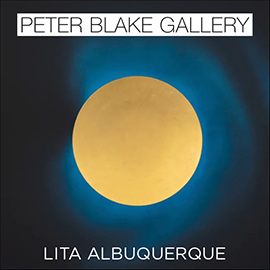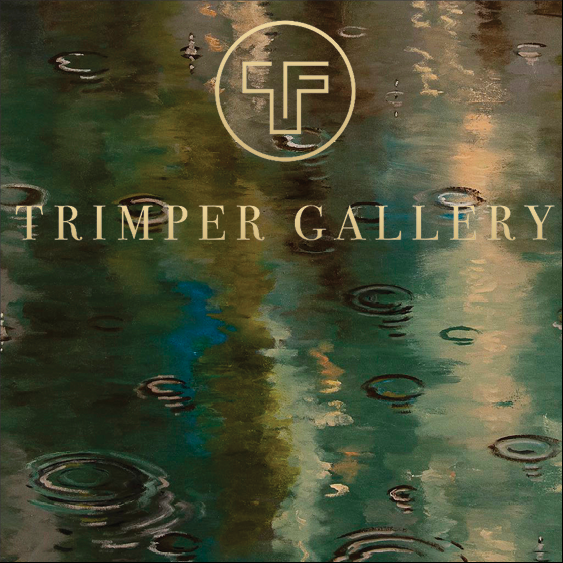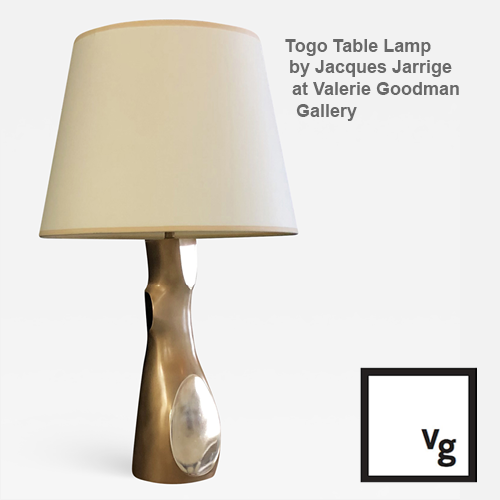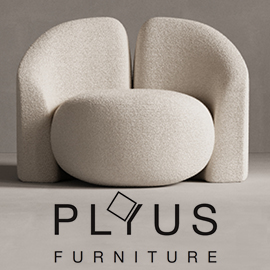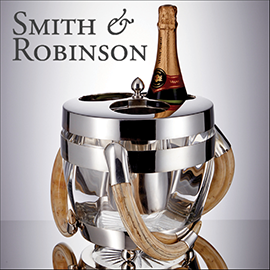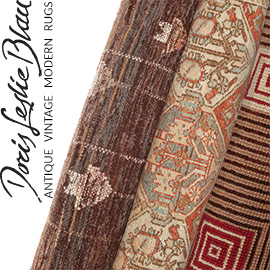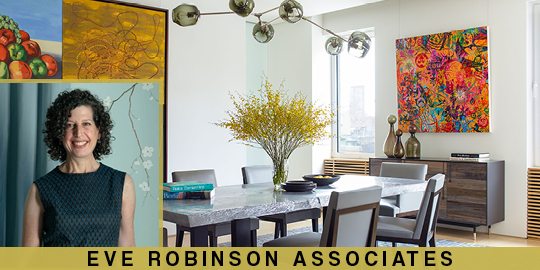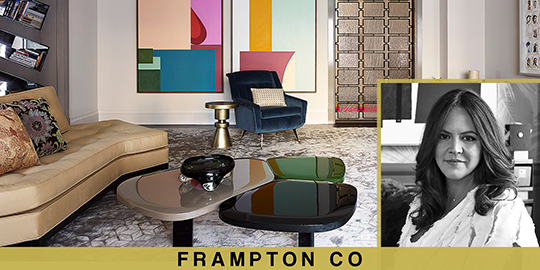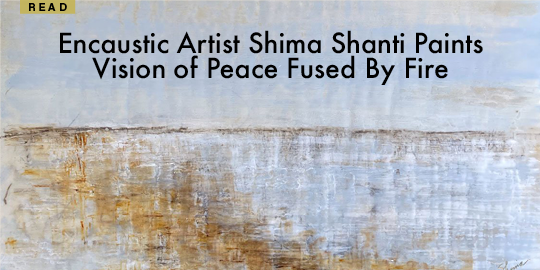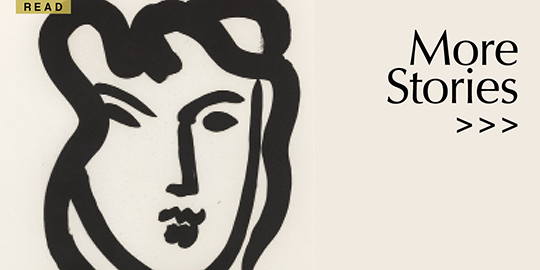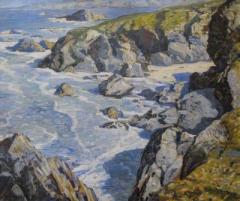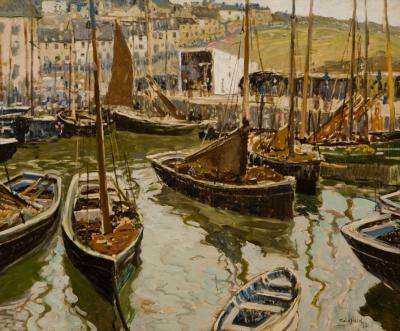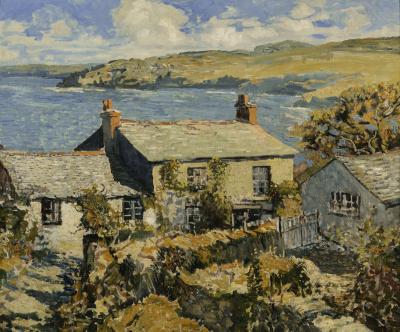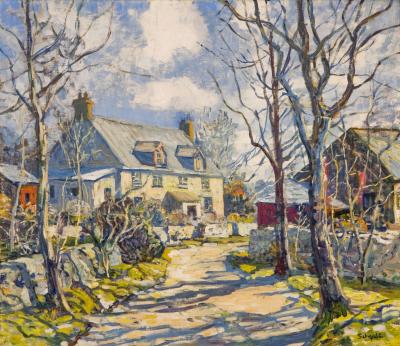Walter Elmer Schofield
American, 1867 - 1944
Many early twentieth century art critics considered Schofield to be one of the daring innovators among American Impressionist landscape painters. As he was quoted in International Studio magazine, February, 1913, “Zero weather, rain, falling snow and wind; all these things to contend with only make the open-air painter love the fight”. Walter Elmer Schofield was born in Philadelphia on September 10, 1867, the son of a prosperous businessman. He attended classes at the Pennsylvania Academy from 1889 to 1892, under Thomas Anshutz. While there, he frequented the Tuesday night open houses that Robert Henri held at his studio. There close friendships developed with Henri, Edward Redfield, William Glackens, Colin Campbell Cooper, Augustus Koopman, Charles Grafly and John Sloan. He left in 1892 to enroll at the Academie Julian in Paris, where he studied under Bouguereau, Gabriel Ferrier, and Henri Lucien Doucet. Schofield met and in 1896, married, an English girl by the name of Murielle Redmayne. In 1901, they moved abroad to St. Ives in Cornwall. Although Walter Elmer Schofield established his residence in England, he made annual trips to the United States where he usually remained from October through April. He spent much of his time painting his famed Pennsylvania snow scenes, when not attending to obligations to Galleries and art institutions. The majority of Schofield's work depicts the coastal fishing villages of Cornwall and Devon. The rolling hillsides, rocky coasts and clusters of cottages made for desirable subjects. His stately manor house in Cornwall, called "Godolphin”, with its rich grounds, lily pond and formal gardens, also provided the artist with idyllic scenery to paint. Often compared to his contemporary, Redfield, a competitive rivalry developed between the two artists. A frequent visitor to Edward Redfield's home in Bucks County, Schofield became convinced that painting large canvases out of doors with bold, rapid brush strokes was the direction he wished to follow. By 1904, animosity had developed between the two artists and their friendship cooled. During his lifetime he garnered many awards, medals and prizes. His exhibition record includes the Pennsylvania Academy of the Fine Arts(1903 Gold Medal,1914 Gold Medal), the Paris Salon, the Philadelphia Art Club(1898 prize), the Society of American Artists(1900 prize), the Paris Exposition(1900 prize), the National Academy of Design(1901 prize,1911 Gold Medal,1920 prize), the Pan-American Exposition in Buffalo, the Carnegie Institute(1904 medal), the St. Louis Exposition(1904 medal), the Corcoran Gallery Biennials(1926 Silver Medal), the Art Institute of Chicago(1921 prize), the National Arts Club(1913 Gold Medal and prize), the Panama Pacific Exposition in San Francisco(1915 Silver Medal) and the Sesquicentennial Exposition in Philadelphia(1926 Silver Medal). His work is in the permanent collections of the Metropolitan Museum of Art, the Woodmere Art Museum, the James A. Michener Art Museum, the Corcoran Gallery of Art, the Cincinnati Art Museum, the Carnegie Institute, the Albright Art Gallery in Buffalo, the Pennsylvania Academy of the Fine Arts, the Art Institute of Chicago, the Luxembourg Museum in Paris, and the National Museum of American Art at the Smithsonian Institute among others. Sources: New Hope for American Art by James M. Alterman - International Studio, February, 1913 -Arts and Decoration, October, 1911. -New York Times, March 3, 1944.
Walter Schofield Paintings & Art
Walter Schofield Paintings & Art
Schofield was born on 10th September 1867 in Philadelphia. His parents had emigrated from England, and his father became part owner of Delph Spinning Company in Philadelphia. Not enjoying the best of health as a child, he was sent out West by his father to toughen him up, and, for eighteen months in 1884/5, he lived the life of a cowboy. His earliest works date from this period.
Between 1889 and 1892, he studied at the Pennsylvania Academy of Fine Arts before, in late 1892, going to Paris, where he enrolled at Julian's Academy, studying under Bouguereau, Ferrier, Aman-Jean and Doucet. During his three years in Paris, he traveled to Fontainebleau and Brittany and was fired with enthusiasm for Impressionism.
In 1894, he returned to the States and tried to work in the family business but it did not suit him. He returned to Europe in 1895 with his charismatic and influential friend, Robert Henri, and fellow art student, William Glackens, and, from Paris, they cycled round Holland and Belgium to view the Dutch masters. The following year, he visited England. In October 1897, he married Muriel Redmayne of Southport, whom he had met initially in Philadelphia. She did not take to life in America and so, in 1901, they emigrated to England, living initially in Southport. In 1903, now with two young sons, they moved to St Ives, Cornwall, where they stayed for four years, during which time he was instrumental not only in recommending St Ives to other American artists, such as George Oberteuffer and Frank Shill, but also in getting work by his St Ives colleagues, such as Hayley Lever, hung at Pittsburg and other American shows.
Schofield was primarily a landscape painter, and this was the period when the landscape and marine work of the St Ives artists Arnesby Brown, Julius Olsson, Algernon Talmage, Noble Barlow and Arthur Meade was winning high plaudits at the Royal Academy. There is little doubt that Schofield was influenced by the plein-air approach of these artists, and he adopted a broader view and lighter palette. Commenting to his friend, C.Lewis Hind, on his new found enthusiam, he stated, "Zero weather, rain, falling snow, wind - all of these things to contend with only make the open-air painter love the fight...He is an open-air man, wholesome, healthy, hearty, and his art, sane and straightforward, reflects his temperament." In addition, Schofield started to use huge canvases for his outdoor works, and the result was panoramic landscapes, boldly and expansively painted.
Schofield was a restless spirit. No sooner had he settled into any new home that Muriel had located for the family than he would announce Well,it's time to be moving on. And he developed a lifestyle that involved him spending as much as six months a year - normally from October to April - in the States away from his family.
Schofield always favored the American exhibition circuit and American patrons and, as a result, during the first three decades of the twentieth century, he became regarded as one of America's leading landscape painters and is now lauded as one of the most important of the American Impressionists.
His medal tally at American and International exhibitions is impressive and include a 'Mention Honorable' at the Paris Salon in 1900, a First Class Medal at the Carnegie Institute in 1904, a Gold Medal at the 1910 Buenos Aires Exhibition, the Medal of Honor from the Panama-Pacific International Exposition in San Francisco in 1915 and a silver medal at the Corcoran Gallery of Art, Washington D.C. in 1926. In fact, the Corcoran held three one-man exhibitions of his work in 1912, 1920 and 1931 and he was well-respected in art circles, serving on exhibition juries and selection committees.
Schofield made more than forty crossings of the Atlantic by steamer, and, between 1902 and 1937, the only years when he did not visit the States were the War years. In 1915, aged 48, Schofield felt so deeply about Germany's actions that he enlisted as a private soldier in the Royal Fusiliers but, with Olsson's assistance, he received a commission from the Royal Artillery the following year. He fought at the Somme and rose to the rank of Major but his only painting exploits were in camouflaging the guns under his command. In 1921, he returned to Cornwall, living at Doreen Cottage at Perranporth for four years, although, as always, he was constantly away from home, seeking new subjects, new inspiration and, most importantly, new purchasers. In 1925, the family moved to Otley, Suffolk, where his son, Sidney had started farming.
In the late 1920s and 1930s, with his marriage under strain, Schofield spent as much as nine months a year in the States and, in addition to returning as always to his home state of Pennsylvania, he spent long periods in California, Arizona and New Mexico, where he painted scenes of the American West. However, when his son, Sidney, in 1937, purchased Godolphin House, the impressive manor dating from the 15th century, near Helston, he could not resist the lure of Cornwall again, and he and his wife moved in during the autumn of 1938. He immediately joined the St Ives Society of Artists - Moffat Lindner, Fred Milner and Arthur Meade would have been colleagues from his first visit to St Ives - and his exhibits soon were highly applauded. In 1941, after his son's marriage, he moved to Gwedna House, a smaller residence on the estate, where he died from a heart attack in 1944.
Biography courtesy of Roughton Galleries, www.antiquesandfineart.com/roughton
Between 1889 and 1892, he studied at the Pennsylvania Academy of Fine Arts before, in late 1892, going to Paris, where he enrolled at Julian's Academy, studying under Bouguereau, Ferrier, Aman-Jean and Doucet. During his three years in Paris, he traveled to Fontainebleau and Brittany and was fired with enthusiasm for Impressionism.
In 1894, he returned to the States and tried to work in the family business but it did not suit him. He returned to Europe in 1895 with his charismatic and influential friend, Robert Henri, and fellow art student, William Glackens, and, from Paris, they cycled round Holland and Belgium to view the Dutch masters. The following year, he visited England. In October 1897, he married Muriel Redmayne of Southport, whom he had met initially in Philadelphia. She did not take to life in America and so, in 1901, they emigrated to England, living initially in Southport. In 1903, now with two young sons, they moved to St Ives, Cornwall, where they stayed for four years, during which time he was instrumental not only in recommending St Ives to other American artists, such as George Oberteuffer and Frank Shill, but also in getting work by his St Ives colleagues, such as Hayley Lever, hung at Pittsburg and other American shows.
Schofield was primarily a landscape painter, and this was the period when the landscape and marine work of the St Ives artists Arnesby Brown, Julius Olsson, Algernon Talmage, Noble Barlow and Arthur Meade was winning high plaudits at the Royal Academy. There is little doubt that Schofield was influenced by the plein-air approach of these artists, and he adopted a broader view and lighter palette. Commenting to his friend, C.Lewis Hind, on his new found enthusiam, he stated, "Zero weather, rain, falling snow, wind - all of these things to contend with only make the open-air painter love the fight...He is an open-air man, wholesome, healthy, hearty, and his art, sane and straightforward, reflects his temperament." In addition, Schofield started to use huge canvases for his outdoor works, and the result was panoramic landscapes, boldly and expansively painted.
Schofield was a restless spirit. No sooner had he settled into any new home that Muriel had located for the family than he would announce Well,it's time to be moving on. And he developed a lifestyle that involved him spending as much as six months a year - normally from October to April - in the States away from his family.
Schofield always favored the American exhibition circuit and American patrons and, as a result, during the first three decades of the twentieth century, he became regarded as one of America's leading landscape painters and is now lauded as one of the most important of the American Impressionists.
His medal tally at American and International exhibitions is impressive and include a 'Mention Honorable' at the Paris Salon in 1900, a First Class Medal at the Carnegie Institute in 1904, a Gold Medal at the 1910 Buenos Aires Exhibition, the Medal of Honor from the Panama-Pacific International Exposition in San Francisco in 1915 and a silver medal at the Corcoran Gallery of Art, Washington D.C. in 1926. In fact, the Corcoran held three one-man exhibitions of his work in 1912, 1920 and 1931 and he was well-respected in art circles, serving on exhibition juries and selection committees.
Schofield made more than forty crossings of the Atlantic by steamer, and, between 1902 and 1937, the only years when he did not visit the States were the War years. In 1915, aged 48, Schofield felt so deeply about Germany's actions that he enlisted as a private soldier in the Royal Fusiliers but, with Olsson's assistance, he received a commission from the Royal Artillery the following year. He fought at the Somme and rose to the rank of Major but his only painting exploits were in camouflaging the guns under his command. In 1921, he returned to Cornwall, living at Doreen Cottage at Perranporth for four years, although, as always, he was constantly away from home, seeking new subjects, new inspiration and, most importantly, new purchasers. In 1925, the family moved to Otley, Suffolk, where his son, Sidney had started farming.
In the late 1920s and 1930s, with his marriage under strain, Schofield spent as much as nine months a year in the States and, in addition to returning as always to his home state of Pennsylvania, he spent long periods in California, Arizona and New Mexico, where he painted scenes of the American West. However, when his son, Sidney, in 1937, purchased Godolphin House, the impressive manor dating from the 15th century, near Helston, he could not resist the lure of Cornwall again, and he and his wife moved in during the autumn of 1938. He immediately joined the St Ives Society of Artists - Moffat Lindner, Fred Milner and Arthur Meade would have been colleagues from his first visit to St Ives - and his exhibits soon were highly applauded. In 1941, after his son's marriage, he moved to Gwedna House, a smaller residence on the estate, where he died from a heart attack in 1944.
Biography courtesy of Roughton Galleries, www.antiquesandfineart.com/roughton
